How the Kletzsch Fishway Was Created
And how it will change the Milwaukee River and its fish.

Aaron Schiller, fisheries biologist with Wisconsin Department of Natural Resources, points across the Kletzsch Dam in August 2023 toward the excavation of the Kletzsch fishway. It’s a bypass designed to unlock access to critical spawning habitat for fish like northern pike and lake sturgeon, a species once extirpated from the Milwaukee River but now being reintroduced in hopes to reestablish a naturally reproducing population. Photo by Michael Timm,
This is the first article in a series from a new partnership with environmental nonprofit Reflo.
It was this big. So begins, with arms spread wide, every great fish tale.
One such story is about the Milwaukee River in Kletzsch Park, where the work to add a “fishway” bypassing the Kletzsch Dam is part of a larger strategic effort to renegotiate our relationship with water. Considering the past 200 years, these projects seek to reverse our relationship to the river: from cinching its flow with dams to redesigning watercourses from a whole watershed view led by respect for species other than our own. This includes lake sturgeon, a species locally wiped out, but now the focus of a decades-long collaborative effort to restore naturally producing populations in a river system their ancestors once called home.
The picturesque scene on any given day at Kletzsch Park in the leafy suburb of Glendale belies this intergenerational drama. Water pours over the sinuous Kletzsch Dam—often mistaken for a natural falls but actually a Depression-era Civilian Conservation Corps project built for recreation—enveloping the west bank in a soft cloud of sound.
Visitors, perched at picnic tables beneath the dappled shade of mature oaks that tower above eroded slopes, gaze at the dam or just downstream where sun-speckled riffles reveal dark cobble protruding from the shallows.
A sexual urge draws fish here, season after season, to push upriver to spawn. This primal drive in turn attracts human anglers, who wade knee-deep into the river with hook and line to pursue the mystery of what lies beneath.
Some fish—introduced species like salmon or steelhead—launch muscular silver bodies into the air in attempt to overcome barriers.
Imagine Giannis Antetokounmpo, all six foot eleven inches of the Milwaukee Bucks superstar, vaulting over a 10-foot basketball hoop and you have some idea of what it means to be a fish facing turbulence at the dam.
Native fish like northern pike or lake sturgeon cannot make this jump. At Kletzsch, 11 miles upstream from where river meets their wintering waters of Lake Michigan beneath the Hoan Bridge, their path to progeny is blocked.
Until now.
Excavation and construction began in summer 2023 on a “nature-like fishway” to circumvent this hurdle to fish passage.
“It took about seven years for us to come up with a design and a solution that made everyone happy. Essentially we designed a stream that will take the fish up and around the dam and bring them to happier, higher quality habitat up north,” explained Natalie Dutack, Area of Concern program supervisor with Milwaukee County Parks, which has partnered with Milwaukee Metropolitan Sewerage District (MMSD) and Wisconsin Department of Natural Resources (WDNR) on this approximately $3.3 million project that includes needed repairs to the dam itself.
After its December 2023 completion, the Kletzsch fishway promises to reconnect fish in Lake Michigan and the lower Milwaukee River with 25 miles of river upstream, an additional 29 miles of tributary streams, and 2,400 acres of wetlands, according to a fact sheet from the Waterway Restoration Partnership (WRP).
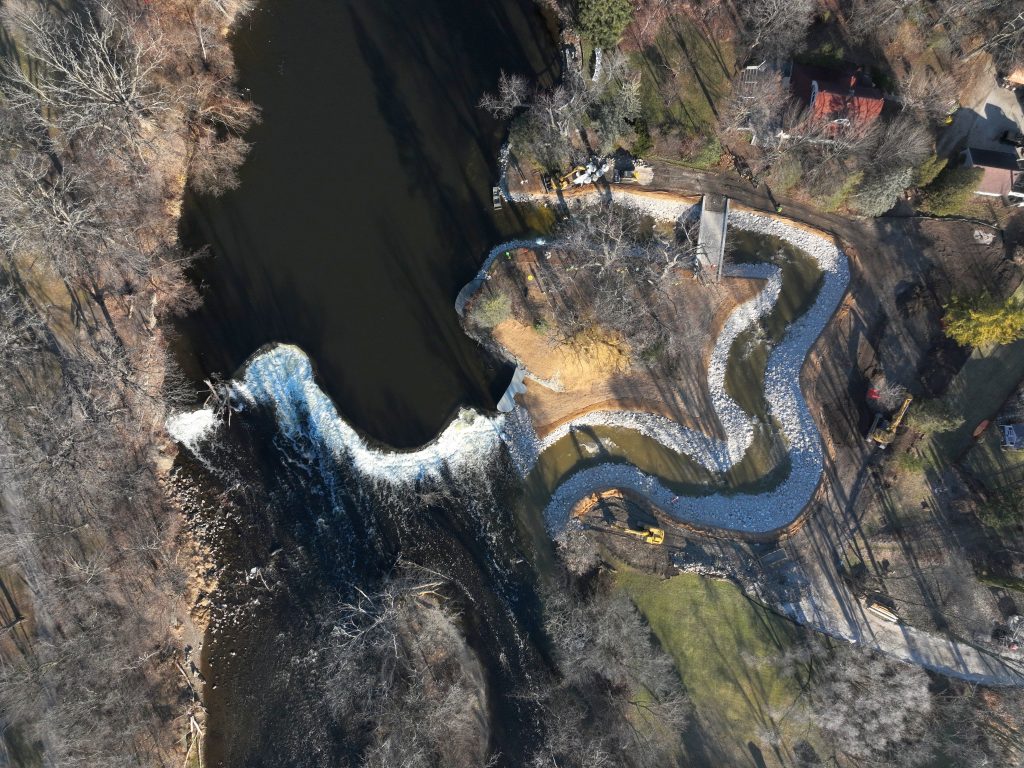
An aerial image of the Kletzsch Dam and fishway on December 12, 2023 when it opened to Milwaukee River waters. Photo courtesy Waterway Restoration Partnership.
The WRP is a super-group of entities including Parks, MMSD, and WDNR. The partners united to accomplish projects informed by decades of monitoring and science identifying how and where to undo critical impairments to the Milwaukee Estuary “Area of Concern (AOC)”—the lower reaches of Milwaukee’s three rivers, their confluence, several tributaries, and the harbor.
It’s proved a powerful partnership so far.
In fall 2023 the federal government announced a historic $275 million award to remove and sequester contaminated river sediment—matched against some $170 million in non-federal funding. That estimated $450 million sediment project constitutes the largest cleanup effort ever under the U.S. Environmental Protection Agency’s Great Lakes Restoration Initiative (GLRI) and the Great Lakes Legacy Act.
But removing habitat impairments is equally important, and GLRI previously awarded approximately $2.8 million to support the Kletzsch project.
The fishway is a bit like a wheelchair ramp circumventing a steep stairwell. The Kletzsch Dam remains, but native fish can navigate upstream via a series of resting pools connected through a gentler gradient in a new channel cut into the Milwaukee River’s east bank.
If the fishway performs as designed, it will reunite thousands of maturing native fish with the beneficial waters they need to spawn their next generation.
“Connectivity in this system has been broken for so long,” explained Jeff Houghton, fisheries biologist with the UW-Milwaukee School of Freshwater Sciences.
One goal of the Kletzsch fishway is to restore that connectivity and reestablish a naturally reproducing population of lake sturgeon in the Milwaukee River. Lake sturgeon are a slow-maturing native species once wiped out locally. But now they are beneficiaries of almost two decades of state and partner efforts to reintroduce this iconic fish with Native American significance.
Houghton points to lake sturgeon as an indicator of overall water quality. “This work is good not just for sturgeon but for other species like pike and bass,” he explained. “If the sturgeon are doing well, other species will as well.”
Preparing for the opening of the historic passage, Houghton has surveyed, mapped, and analyzed the Milwaukee River up to the Ozaukee County line to identify suitable sturgeon spawning habitat. So far six promising sites have been identified, including a stretch between Kletzsch and Estabrook Parks. “We need to dig in a little further to know whether substrate [bottom material] already exists or if it could be improved,” Houghton said.
North of the Milwaukee/Ozaukee County line, the domain of Ryan Miller, fisheries biologist with Ozaukee County, the picture is even more promising. Over the past years, Miller paddled a canoe with a portable sonar unit to map a cumulative 14 stream miles. At a 2023 public outreach event, Miller noted that over 40% of the river’s reach in Ozaukee County contains substrate identified as cobble—high value for potential sturgeon spawning habitat.
With the completion of the Kletzsch fishway, fish will be able to access this upstream spawning habitat, said Aaron Schiller, WDNR fisheries biologist. Mapping work by Houghton and Miller so far suggests at least 20 sites in all, Schiller said.
“As you go upstream, especially Grafton down through Lime-Kiln [a former dam], that’s all great gradient, big drop, good rock, there’s deep holes available for the adults to sit in, and good stretches of that faster water because it’s actually steeper there,” Schiller said. “That flow keeps the rock clean. There’s not sediment in the rock. So when the eggs stick to the rock they’re not getting silted in. So they stay oxygenated. ’Cause they’re real sticky. And once they hatch they have a long stretch to drift of good, clean habitat.”
The Kletzsch fishway is designed for lake sturgeon and northern pike, Schiller said, two native fish with differing swimming styles. “Right now those are the target species because if we improve fish passage for them, everything else can get through.”
Kletzsch presented an engineering challenge. The final design prepared by MMSD’s consultant Interfluve called for seven resting pools curving through about 450 feet of new channel cut on the east bank.
“We realized we needed all of that, because you have these series of ramps and pools and they can’t be too steep and can’t be too long,” said Beth Wentzel, senior project manager who joined MMSD in 2020. Wentzel brought her engineering experience from Interfluve and also redesigning the Mequon-Thiensville fish passage for Ozaukee County in 2021-’22.
The east-bank design emerged after years of public objections to an earlier west bank design which would have removed mature oak trees. MMSD acquired a key floodplain parcel to make an east bank alternative feasible. The $20,000 real estate purchase was covered with part of a Fund for Lake Michigan grant and a donation from Milwaukee Audubon, according to Stacy Hron, WDNR project manager.
“The real estate was a little bit complex because there was a mix of [Milwaukee] County-owned properties, Glendale-owned properties, and a small sliver of privately owned property when we started,” said Wentzel.
The design was based conservatively on lab observations of fish swimming, Schiller noted. “In the lab they don’t have that ambition to really get up and go for spawning drive. Here, we’ll know: water temperature, time of year, and their drive. It’s real-world application. So that’s different than what’s available information right now.”
How will we know if the fishway works?
Part of the answer: an innovative tracking system to count fish as they pass between underwater antennas.
Supported by a $70,000 grant from Fund for Lake Michigan as part of the project, the array will allow WDNR to track fish with PIT tags.
PIT stands for passive integrated transponder. Each tag, slightly longer than a grain of rice, contains a microchip bearing a unique ID code. The tag is injected into a fish’s muscle. When the tag passes near an antenna, it registers the fish, adding to a database Schiller manages.
One antenna monitors each end of the fishway.
“We’ll know how long [tagged fish are] in there, how many made it through successfully, and then if any made it halfway and turned around and came back out, we’ll have that detection as well,” Schiller said.
Combined with another antenna array miles downstream near Urban Ecology Center Riverside and another upstream at the Mequon-Thiensville fishway, the PIT arrays will provide a feast of field data that should improve managers’ understanding of fish population movements.
Annually reintroduced lake sturgeon are the main PIT tag recipients, but Schiller envisions one day tagging suckers, redhorse, smallmouth bass, steelhead, brown trout, and other species of interest.
The area around the dam will be managed as habitat, and WDNR is working through the process to designate the fishway as a fish refuge, WDNR’s Hron said. No angling will be allowed in the fishway.
“Kletzsch is the biggest barrier in the lower 30 miles,” Wentzel said. “But the next one that is significant is at Estabrook Falls [also manmade]. So we’re currently working on a design of a fish passage solution there, and we have a consultant developing designs for that. It’s going to be different than this. We’re not cutting into the bank for that one, but rather, modifying the falls to create places where fish can get through directly in the river. We’re hoping to have funding to do construction on that maybe as soon as late in 2024.”
Another AOC fish passage project considers how to moderate the velocity in the Milwaukee River just upstream of the former North Avenue Dam.
That dam was removed in 1997, ushering in a new era of enhanced water quality, followed by removal of Grafton’s Chair Factory Dam in 2000, the Lime-Kiln Dam removal and Mequon-Thiensville Dam fish passage in 2010, and Estabrook Dam removal in 2018. With the opening of the Kletzsch fishway, the last major barrier to fish passage on the lower Milwaukee River is the Bridge Street Dam in Grafton.
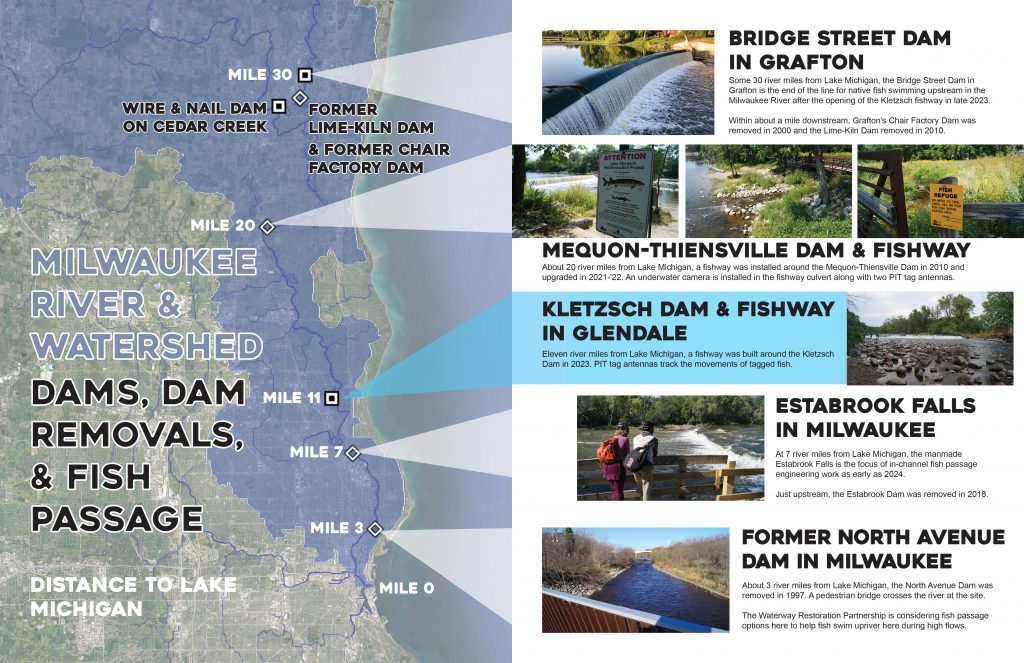
The Kletzsch Dam fishway adds to recent dam removal and fish passage projects along the lower Milwaukee River, restoring connectivity for native fish 30 river miles from Lake Michigan upstream to Grafton’s Bridge Street Dam. Map by Michael Timm.
Those 30 miles of connected river bode well for the return of lake sturgeon. “A lot of people [who] hook into a sturgeon—in Milwaukee at least—have never seen or heard of a sturgeon before,” said Schiller.
That could be about to change.
In late summer two boys stood ankle deep in the river beside Kletzsch Dam, their rods glinting in the mid-morning sun and ambient spray.
To make their way down to the water, they passed an unobtrusive metal WDNR sign posted about sturgeon. The Milwaukee 11-year-olds, who said they come two or three times a week to Kletzsch to fish, were casting for bass.
What did the boys know about sturgeon?
“Not much,” one said. “I’ve never seen one pass through here. I know they can get really big. Like 12 feet long. Which is pretty cool. I don’t really know much else except for that.”
Photos by Michael Timm
Photos
Illustrations
Michael Timm is Milwaukee Water Storyteller for the nonprofit Reflo. He holds a 2013 master’s degree in freshwater science from UW-Milwaukee and a 2004 bachelor’s degree in anthropology and English from Ripon College. He previously wrote and edited for the Bay View Compass newspaper where he edited the H2O column.
This project is funded by the Wisconsin Department of Administration, Wisconsin Coastal Management Program and the National Oceanic and Atmospheric Administration under the terms and conditions of Wisconsin Coastal Management Program Grant Agreement No. AD239125-024.21. | Funded by the Wisconsin Coastal Management Program and the National Oceanic and Atmospheric Administration, Office for Coastal Management under the Coastal Zone Management Act, Grant # NA22NOS4190085

Water Series
-
How Salt Is Polluting State’s Waters
 Mar 29th, 2024 by Michael Timm
Mar 29th, 2024 by Michael Timm
-
Why Do We Care About The Sturgeon?
 Feb 15th, 2024 by Michael Timm
Feb 15th, 2024 by Michael Timm
-
The Return of the Sturgeon
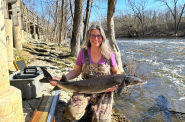 Jan 31st, 2024 by Michael Timm
Jan 31st, 2024 by Michael Timm

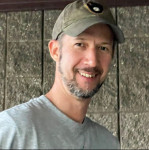
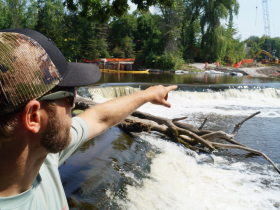
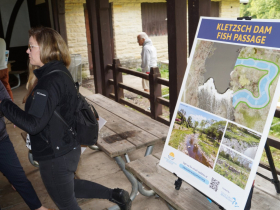
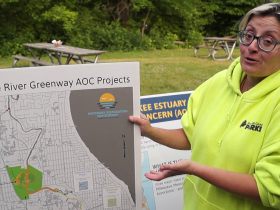
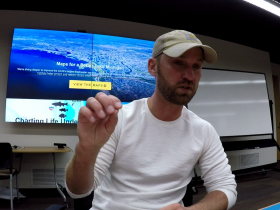
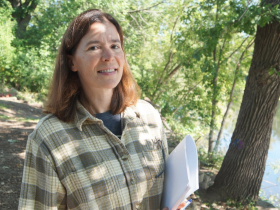
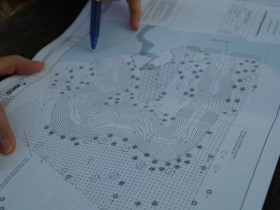
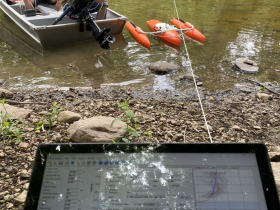
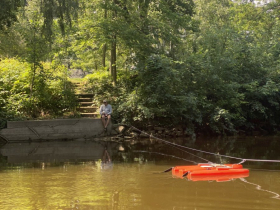
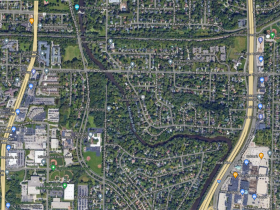
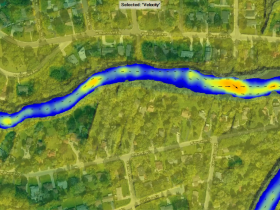
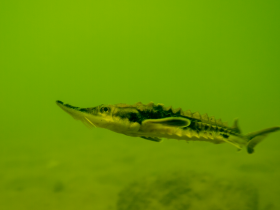
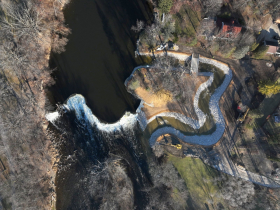
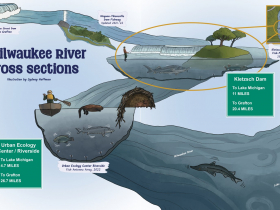
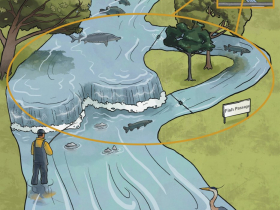
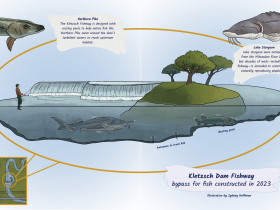


















Great article, a lot to learn and cleverly written. Would enjoy seeing other similar stories related to city and county parks. Good to see UM partnerships with non-profits for stories like these. Great photos
This is a great accomplishment for the entities that got together and got this done. I am sure that some Republican representative was looking for ways to block to make the headlines in the media. They feel tax dollars should not be spent on public recreation just boondoggles like Foxconn. I am also surprised that the Wisconsin Institute for Law and Liberty did not file a lawsuit on this like they do for so many other creative projects that benefits the citizens of Milwaukee County.
What a great update, Michael! I enjoyed this long form article and am looking forward to the future articles under this new partnership. It’s tough to not be awed by nature when witnessing the salmon run at Kletsch. I am very hopeful our future generations will be able to witness the mighty sturgeon because of this project.
As an addendum for paddlers, watercraft or human passage of any kind is not allowed in the fishway (east bank), according to the Waterway Restoration Partnership.
The fishway’s status as fish refuge is intended to provide safe passage for fish but not intended for humans.
To accommodate the passage of watercraft, there are separate plans for new portage facilities on the west bank.